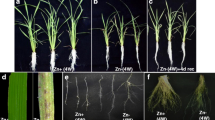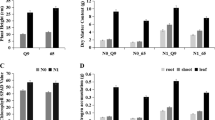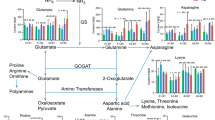Abstract
Zn fertilizer is extensively applied in agricultural practices, which promotes photosynthetic process and growth development; however, Zn fertilizer use efficiency is very low in main crops, and studies on Zn responsive genes (ZRGs) are still lacking. Here, we used transcriptome analysis on peanuts with two Zn soluble resources (ZnSO4.7H2O and ZnCl2) to dissect the ZRGs. Results show that the two Zn resources had significantly positive effects on photosynthetic parameters, including net photosynthetic rates, chlorophyll contents, and photochemical efficiency. Results from transcriptomes on peanuts with different Zn treatments reveal that 862 and 947 genes were upregulated by ZnCl2 (+ 0.1% v/v) and ZnSO4.7H2O (+ 0.3% v/v), relative to the control, respectively. GO and KEGG analysis shows that zinc binding, signal transduction, cell membrane biosynthesis, ion/carbohydrate transport, and amino acids metabolism were significantly enriched in 368 ZRGs, while the top 5% ZRGs with extremely differential expression were further confirmed by qPCR. Results confirm that the genes related to Zn binding and photosynthetic process were upregulated and genes related to defense system were regulated by both Zn treatments. This study reveals multiple signal pathways involved in Zn ion response and emphasizes promoted roles of ion transport and carbohydrate metabolism in Zn fertilizer use efficiency for peanut growth.






Similar content being viewed by others
Data Availability
All data are available in the manuscript or the supplementary materials.
References
Bari R, Datt Pant B, Stitt M et al (2006) PHO2, microRNA399, and PHR1 define a phosphate-signaling pathway in plants. Plant Physiol 141(3):988–999
Barkan A, Small ID (2014) Pentatricopeptide repeat proteins in plants. Annu Rev Plant Biol 65:415–442
Broadley MR, White PJ, Hammond JP, Zelko I, Lux A (2007) Zinc in plants. New Phytol 173:677–702
Broadley M, Brown P, Cakmak I, Rengel Z, Zhao F (2012) Function of nutrients: micronutrients. In: Marschner P (ed) Marschner’s mineral nutrition of higher plants, 3rd edn. Academic Press, San Diego, pp 191–248
Chen JQ, Wu Y, Yang H et al (2009) Variation in the ratio of nucleotide substitution and indel rates across genomes in mammals and bacteria. Mol Biol Evol 26:1523–1531
Clevenger J, Akins PO, Leal-Bertioli S, et al. (2017) 2012–2017 Research accomplishment report to the U.S. peanut industry, Peanut Genome Initiative. 2012–2017 PGI Final Report. pp3.
Colvin RA, Holmes WR, Fontaine CP, Maret W (2010) Cytosolic zinc buffering and muffling: their role in intracellular zinc homeostasis. Metallomics 2:306–317
Dolferus R (1994) Differential interactions of promoter elements in stress responses of the Arabidopsis Adh gene. Plant Physiol 105:1075–1087
Fageria NK, Filho MPB, Moreira A, Guimarães CM (2009) Foliar fertilization of crop plants. J Plant Nutr 32:1044–1064
Farooq M, Basra SMA, Hafeez K, Ahmad N (2005) Use of commercial fertilizers as osmotica for rice priming. J Agri Soc Sci 1:172–175
Franco IAL, Martinez HEP, Zabini AV, Fontes PCR (2005) Translocation and compartmentation of zinc by ZnSO4 e ZnEDTA applied on coffee and bean seedlings leaves. Ci Rural 35:332–339
Galtier N, Bazin E, Bierne N (2006) GC-biased segregation of noncoding polymorphisms in Drosophila. Genetics 172:221–228
Hanafy-Ahmed AH, Khalil MK, Abd-Ei-Rahman AM, Nadia AM (2012) Effect of zinc, tryptophan and indole acetic acid on growth, yield and chemical composition of Valencia orange trees. J Appl Sci Res 8:901–914
Haslett BS, Reid RJ, Rengel Z (2001) Zinc mobility in wheat: uptake and distribution of zinc applied to leaves or roots. Ann Bot 87:379–386
Ho DTH, Scandalios JG (1975) Regulation of alcohol dehydrogenases in maize scutellum during germination. Plant Physiol 6:56–59
Johnson SE, Lauren JG, Welch RM, Duxbury JM (2005) A comparison of the effects of micronutrient seed priming and soil fertilization on the mineral nutrition of chick pea (Lens culinaris), rice (Oryza sativa) and wheat (Triticum aestivum) in Nepal. Exp Agric 41:427–448
Katam R, Sakata K, Suravajhala P et al (2016) Comparative leaf proteomics of drought-tolerant and -susceptible peanut in response to water stress. J Proteomics 143:209–226
Khan GA, Bouraine S, Wege S, Li Y et al (2014) Coordination between zinc and phosphate homeostasis involves the transcription factor PHR1, the phosphate exporter PHO1, and its homologue PHO1;H3 in Arabidopsis. J Exp Bot 65:871–884
Kloubert V, Rink L (2015) Zinc as a micronutrient and its preventive role of oxidative damage in cells. Food Funct 6:3195–3204
Kumar D, Rampuria S, Singh NK, Kirti PB (2016) A novel zinc-binding alcohol dehydrogenase 2 from Arachis diogoi, expressed in resistance responses against late leaf spot pathogen, induces cell death when transexpressed in tobacco. FEBS Open Bio 6(3):200–210
Li B, Dewey CN (2011) RSEM: accurate transcript quantification from RNA-Seq data with or without a reference genome. BMC Bioinform 12:323
Lv Y, Liang Z, Ge M et al (2016) Genome-wide identification and functional prediction of nitrogen-responsive intergenic and intronic long non-coding RNAs in maize (Zea mays L.). BMC Genomics 17:350
Machado AM, Felício M, Fonseca E et al (2018) A resource for sustainable management: de novo assembly and annotation of the liver transcriptome of the Atlantic chub mackerel, Scomber colias. Data Brief 18:276–284
Misson J, Raghothama KG, Jain A et al (2005) A genome-wide transcriptional analysis using Arabidopsis thaliana Affymetrix gene chips determined plant responses to phosphate deprivation. Proc Natl Acad Sci USA 102:11934–11939
Mondo VHV, Dias MAN, McDonald MB (2011) Seed vigor imaging system for two-day-old corn seedling evaluation. Seed Tech 33:191–196
Pandey MK, Monyo E, Ozias-Akins P et al (2012) Advances in Arachis genomics for peanut improvement. Biotechnol Adv 30:639–651
Qu M, Zheng G, Hamdani S, Essemine J, Song Q, Wang H, Chu CC, Sirault X, Zhu XG (2017) Leaf photosynthetic parameters related to biomass accumulation in a global rice diversity survey. Plant Physiol 175:248–258
Rafique E, Rashid A, Ryan JL, Bhatti AU (2006) Zinc deficiency in rainfed wheat in Pakistan: magnitude, spatial variability, management, and plant analysis diagnostic norms. Commun Soil Sci Plant Anal 37(1–2):181–197
Rehman A, Farooq M, Ahmad R, Basra SMA (2015a) Seed priming with zinc improves the germination and early seedling growth of wheat. Seed Sci Technol 43:262–268
Rehman H, Iqbal H, Shahzad MA et al (2015b) Seed priming improves early seedling vigor, growth and productivity of spring maize. J Integr Agric 14:1745–1754
Rengel Z, Graham RD (1995) Wheat genotypes differ in Zn efficiency when grown in chelate-buffered nutrient solution. Plant Soil 2:307–316
Roberts WO (1948) Prevention of mineral deficiency by soaking seed in nutrient solution. J Agric Sci 38:458–468
Robinson MD, McCarthy DJ, Smyth GK (2010) edgeR: a bioconductor package for differential expression analysis of digital gene expression data. Bioinformatics 26:139–140
Rösti J, Barton CJ, Albrecht S et al (2007) UDP-glucose 4-epimerase isoforms UGE2 and UGE4 cooperate in providing UDP-galactose for cell wall biosynthesis and growth of Arabidopsis thaliana. Plant Cell 19:1565–1579
Sadeghzadeh B (2013) A review of zinc nutrition and plant breeding. J Soil Sci Plant Nutr 13:905–927
Shen S, Park JW, Huang J, Dittmar KA, Lu ZX, Zhou Q et al (2012) MATS: a Bayesian framework for flexible detection of differential alternative splicing from RNA-Seq data. Nucleic Acids Res 40:e61
Snel JFH, van Kooten O (1990) The use of chlorophyll fluorescence and other noninvasive spectroscopic techniques in plant stress physiology. Photosynth Res 25:146–332
Tanimoto E, Scott TK, Masuda Y (1989) Inhibition of acid-enhanced elongation of Zea mays root segments by galactose. Plant Physiol 90:440–444
Tapiero H, Tew KD (2003) Trace elements in human physiology and pathology: zinc and metallothioneins. Biomed Pharmacother 57:399–411
Trapnell C, Pachter L, Salzberg SL (2009) TopHat: discovering splice junctions with RNA-Seq. Bioinformatics 25:1105–1111
Wagner GP, Kin K, Lynch VJ (2012) Measurement of mRNA abundance using RNA-seq data: RPKM measure is inconsistent among samples. Theory Biosci 131:281–285
Wang J, Yu Y-C, Li Y, Chen L-Q (2022) Hexose transporter SWEET5 confers galactose sensitivity to Arabidopsis pollen germination via a galactokinase. Plant Physiol 189:388–401
Wheeler TJ, Eddy SR (2013) nhmmer: DNA homology search with profile HMMs. Bioinformatics 29:2487–2489
Xie C, Mao X, Huang J, Ding Y, Wu J, Dong S et al (2011) KOBAS 2.0: a web server for annotation and identification of enriched pathways and diseases. Nucleic Acids Res 39:W316–W322
Xu Z, Jiang Y, Zhou G (2015) Response and adaptation of photosynthesis, respiration, and antioxidant systems to elevated CO2 with environmental stress in plants. Front Plant Sci 10(6):701. https://doi.org/10.3389/fpls.2015.00701
Zhang J, Liang S, Duan J et al (2012) De novo assembly and characterization of the transcriptome during seed development, and generation of genic-SSR markers in peanut (Arachis hypogaea L.). BMC Genomics. https://doi.org/10.1186/1471-2164-13-90
Zhu YG, Smith SE, Smith FA (2001) Plant growth and cation composition of two cultivars of spring wheat (Triticum aestivum L.) differing in P uptake efficiency. J ExpBot 52:1277–1282
Zhuang W, Chen H, Yang M et al (2019) The genome of cultivated peanut provides insight into legume karyotypes, polyploid evolution and crop domestication. Nat Genet 51:865–876
Acknowledgements
This work was supported by Natural Science Foundation of Zhejiang Province (Grant No: LQ20C130003) and Scientific Research Fund of Zhejiang Provincial Education Department (Y202248468). We thank Zhongkang Omics Ltd. Corp. for technical service on transcriptome analysis.
Author information
Authors and Affiliations
Contributions
Conceptualization, YML.; Methodology, SL, CL; Investigation, SL, CL, YL; Statistical analysis, SL, CL, YL; Writing, YML, YL; Funding Acquisition, CL, SL Resources, CL, Supervision, YML.
Corresponding author
Ethics declarations
Competing interest
The authors declare that they have no competing interest.
Additional information
Handling Editor: Jose M. Miguel.
Publisher's Note
Springer Nature remains neutral with regard to jurisdictional claims in published maps and institutional affiliations.
Supplementary Information
Below is the link to the electronic supplementary material.
Rights and permissions
Springer Nature or its licensor holds exclusive rights to this article under a publishing agreement with the author(s) or other rightsholder(s); author self-archiving of the accepted manuscript version of this article is solely governed by the terms of such publishing agreement and applicable law.
About this article
Cite this article
Liu, S., Liu, C., Li, Y. et al. Determination of Zn Responsive Genes Involved in Zn Fertilization in Peanuts Based on Transcriptome Analysis. J Plant Growth Regul 42, 3162–3172 (2023). https://doi.org/10.1007/s00344-022-10781-4
Received:
Accepted:
Published:
Issue Date:
DOI: https://doi.org/10.1007/s00344-022-10781-4




